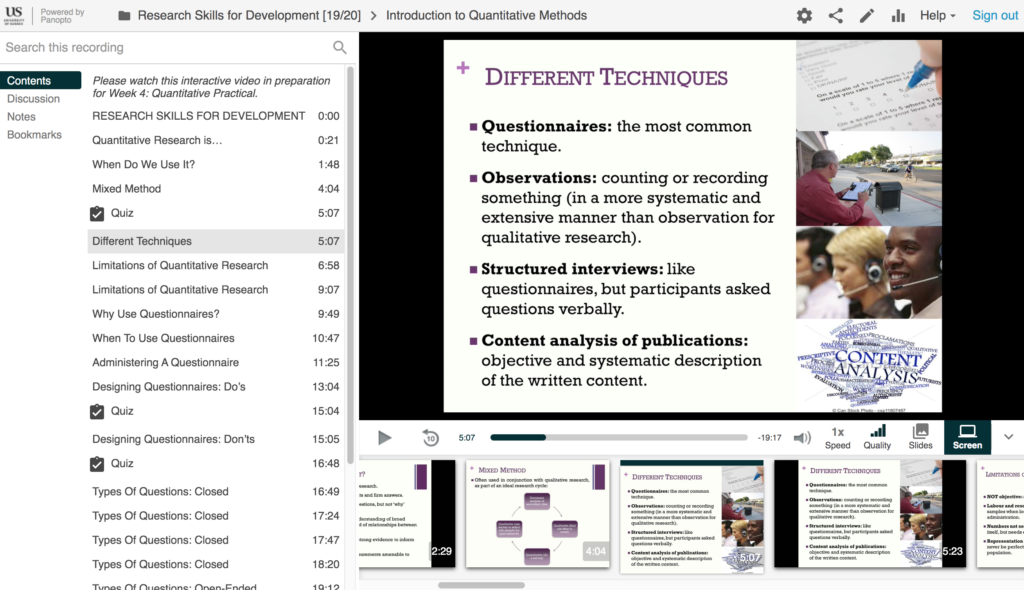Welcome to 2020 – Panopto quizzes

Happy New Year. We hope those of you able to attend the School of Education Forum in December enjoyed the technology session on augmented reality, Book creator ebooks and using Chroma-key technology – green screen.
At a time when maybe thoughts turn to New Year resolutions, whether you are opting out of alcohol or eating a vegan diet, how about thinking about refreshing your teaching by adding a small amount of blended or flipped learning into your modules.
It is a few years since our last blended learning/panopto blog post so maybe it is time for a refresh.
There is a recent flipped learning case study on the University of Sussex TEL blog. Sussex have recently introduced Panopto and also use Canvas so you may find this interesting and useful.
Case Study
In International Development, Dr Anna Laing and Dr Benjamin Hunter have flipped their classroom for a module in Research Methods. They have produced interactive video lectures, which students are expected to do in their own time. The videos give an introductory ‘how to’ lecture on each of the research methods that they teach on the module – quantitative methods, qualitative methods, and participatory approaches. These are short roughly twenty minute videos that are broken up by quizzes on the lecture material to check the students’ understanding of the material. The students must watch the videos before they attend class. Dr Laing and Dr Hunter chose to flip their classroom so they could utilize the classroom time to practice the research skills that they had learnt… Follow this link if you would like to read the entire blog post.
Quizzes
The screen shot above shows how the Sussex team used the quiz tool within Panopto for improving engagement with the students. In this example three separate quizzes can be seen in the contents list for the video. Each quiz could contain one or more questions.
Panopto allows you to create quizzes which can be set to appear to viewers at predetermined points in the recording. There are four types of questions you can add to quizzes:
- True/ False – questions with answers that are either true or false.
- Multiple Choice – several answers present, but only one answer can be chosen as correct.
- Multiple Select – several answers present with multiple correct answers.
- Fill In The Blank – questions that require users to fill in answers to the question. The prompt will ask for the correct answer to be provided.
Quizzes allow you to gauge students’ understanding and comprehension of the materials they are viewing. Panopto allows you to view the results of quizzes, including which questions students got right or wrong and what percentage of students chose a particular answer, in this way quizzes can serve as a method of informal formative assessment.
Students can also review quizzes after they have taken them to see which questions they got right or wrong. This can allow students to gauge their own understanding of a topic and identify knowledge gaps. If you use the option to add feedback comments on the answers students can be informed as to why their answer was right or wrong.
Quizzes can also increase student engagement with recordings. Breaking up long lectures with activities increases the chances that students will remain engaged and pay attention to the entirety of the recording. We would also recommend keeping the videos short and using more than one video if appropriate.
(The quizzes section above has been adapted from Sussex TEL blog Focus on Panopto: Quizzes and Discussions.)
For further guidance on quizzes please see the Panopto Quiz guidance page, or arrange for your team to have a session with us.
When viewing Panopto videos the online interface at https://ljmu.cloud.panopto.eu/ is now running version 8. One of the new features of version 8 is that you can now choose to allow the students to download the slides in your presentation. Instructions on how to do this are here. You can go back to earlier recordings and activate this permission if you desire.
The extracts from the Sussex Blog are reproduced under . Creative Commons Attribution-NonCommercial-ShareAlike 4.0 International License.
